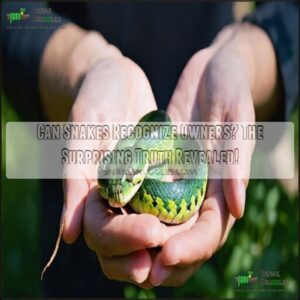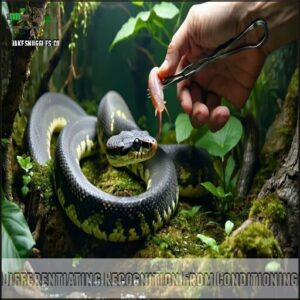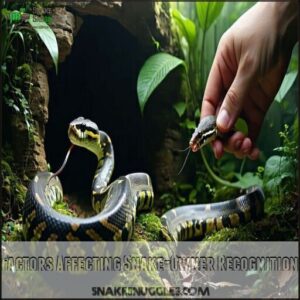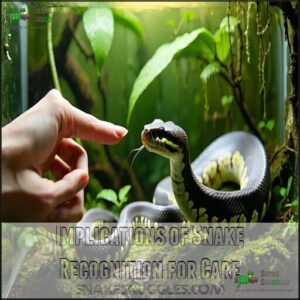This site is supported by our readers. We may earn a commission, at no cost to you, if you purchase through links.

They’re not just cold-blooded creatures, but intelligent reptiles with remarkable perception. Using their exceptional heat-sensing pit organs and keen sense of smell, snakes can actually distinguish familiar humans from strangers.
Their tongue-flicking behavior helps them collect scent information, creating a "chemical signature" of their caretakers. While they won’t show affection like dogs, many snake owners report their pets displaying calm, reduced defensive behaviors when handled consistently.
Scientific research suggests snakes develop learned recognition patterns through repeated interactions, proving they’re more perceptive than most people realize, and have a unique ability to recognize their owners.
Table Of Contents
- Key Takeaways
- Snake Recognition: Myth or Reality?
- Sensory Abilities of Snakes
- How Snakes Identify Their Surroundings
- Snake-Owner Interactions and Behavioral Patterns
- Signs of Familiarity in Captive Snakes
- Differentiating Recognition From Conditioning
- Factors Affecting Snake-Owner Recognition
- Implications of Snake Recognition for Care
- Future Research on Snake Recognition
- Frequently Asked Questions (FAQs)
- Do snakes recognize their owners?
- Do snakes recognize and remember different people?
- Do snakes recognize humans?
- Do snakes know their keeper?
- Do snakes form bonds with their owners?
- Do snakes have a relationship with humans?
- Do snakes get attached to their owners?
- How do you know if a snake likes you?
- Can snakes remember who you are?
- Do snakes like being held?
- Conclusion
Key Takeaways
- You’ll discover snakes recognize you through scent and vibration, not emotional attachment. Their unique sensory abilities like heat-sensing pit organs and chemical recognition help them distinguish familiar humans from strangers.
- Don’t expect a cuddly bond—snakes tolerate you through learned associations and consistent handling. Their recognition is primarily a survival mechanism, not an emotional connection.
- Your snake’s familiarity develops through predictable interactions that reduce stress. By maintaining gentle, routine handling and creating a stable environment, you’ll help your snake become more comfortable with your presence.
- Scientific research reveals snakes have remarkable cognitive abilities, with species like ball pythons demonstrating sophisticated sensory processing. They can remember and respond to your chemical signature and handling patterns, challenging traditional views about reptile intelligence.
Snake Recognition: Myth or Reality?
You’ve probably wondered if your slithery companion can truly recognize you, and the answer might surprise you.
While snakes don’t bond like dogs or cats, they do possess remarkable sensory abilities that allow them to identify and remember their owners through unique chemical, thermal, and vibrational cues, which is a unique aspect of their behavior.
Slithery scientists reveal: Snakes map their world through invisible chemical whispers and thermal secrets, defying our expectations of recognition.
Scientific Studies on Snake Cognition
Explore the fascinating world of snake cognition, where these slithery creatures defy our expectations.
Scientific studies are turning the tables on what we thought we knew about snake intelligence. Check out their surprising cognitive abilities:
- **Self-recognition through chemical cues reveals a hidden depth of sensory perception.
Researchers are uncovering remarkable problem-solving skills and memory retention that challenge traditional views.
Their sensory abilities and learning mechanisms prove snakes are far more complex than we ever imagined, showcasing an incredible adaptive intelligence that’ll make you rethink everything you know about these remarkable reptiles.
Anecdotal Evidence From Snake Owners
While scientific studies provide insights, snake owner experiences reveal fascinating bonding stories.
Unique behaviors emerge as these reptiles show surprising personality recognition during handling.
Some owners notice their snakes relaxing or displaying curiosity, suggesting a deeper snake-owner relationship.
These anecdotal connections challenge our understanding of snake interactions, hinting that these cold-blooded creatures might recognize and respond to consistent, gentle care in their own remarkable way.
Comparison With Other Reptile Recognition Abilities
While snake recognition lags behind other reptiles, their cousins showcase remarkable cognitive abilities.
Lizards excel at social learning, turtles demonstrate individual recognition, and crocodiles respond to familiar humans.
Your snake mightn’t recognize you like a bearded dragon would, but it’s exploring its world through incredible sensory adaptations.
Each reptile species tells a unique story of intelligence beyond our expectations.
Their cognitive abilities, including spatial and social learning, are being increasingly recognized.
Factors Influencing Snake Recognition Capabilities
After comparing reptile recognition skills, let’s explore why some snakes seem more attuned to their owners. Your snake’s sensory acuity and learning capacity play key roles in owner recognition.
Environmental stability and interaction frequency shape their cognitive abilities.
- Gentle handling whispers trust
- Consistent routines build familiarity
- Enriched spaces spark curiosity
Understanding your snake’s unique scent perception and vibration sensitivity can transform your connection from mere ownership to mutual understanding, based on mutual understanding.
Sensory Abilities of Snakes
If you’ve ever wondered how snakes perceive their world, you’re in for a fascinating journey through their unique sensory landscape.
Snakes rely on an extraordinary array of specialized abilities—including heat-sensing pit organs, remarkable tongue-flicking behavior, and sensitive vibration detection—that allow them to navigate and understand their environment in ways that might surprise you.
Visual Perception in Snakes
Think of snake eyes as precision instruments finely tuned for survival.
Their visual perception might surprise you—they excel at motion detection, tracking prey with remarkable accuracy.
While not as sharp as human vision, snakes can distinguish colors and gauge depth, transforming their seemingly limited eyesight into a sophisticated visual system that guides them through complex environments.
Snakes also possess forked tongue sensory capabilities, which helps them to detect chemical gradients.
Olfactory Capabilities and Tongue Flicking Behavior
Have you noticed how snakes seem to "read" the air with their flickering tongues? They’re actually performing an incredible sensory dance, collecting airborne chemical signals through their unique vomeronasal organ.
This remarkable system allows them to differentiate scents with stunning precision, mapping out their environment like living, breathing chemical detectors.
- Snakes decode complex scent trails, transforming invisible molecules into a vivid landscape of information.
Their tongue flicking isn’t just movement—it’s a sophisticated olfactory learning technique that reveals the hidden world around them.
Heat-sensing Abilities Through Pit Organs
Ever wondered how snakes hunt in pitch-black darkness?
Their pit organs act like built-in thermal goggles, detecting infrared radiation from warm-blooded prey.
These vase-shaped sensory structures near their nostrils convert heat signatures into electrical signals, creating a "heat vision" that works within 50 centimeters.
Unlike human vision, these specialized organs respond in less than half a second, revealing a remarkable environmental adaptation that gives pit vipers an extraordinary hunting advantage in complete darkness, and this is a result of their ability to detect infrared radiation and utilize thermal goggles.
Vibration Detection and Sensitivity
If you’ve ever wondered how snakes perceive their world, their vibration detection is mind-blowing! Snakes are nature’s seismic experts, using belly scales as incredible sensory tools.
- Feel microscopic ground tremors
- Detect predator movements instantly
- Navigate complex environments silently
- Communicate through subtle vibrations
Through ground vibration and body sensitivity, snakes transform tiny environmental signals into critical survival information.
Their belly scales act like sophisticated sensors, allowing them to detect approaching threats and track prey with astonishing precision—a demonstration of their remarkable evolutionary adaptation.
How Snakes Identify Their Surroundings
You might be surprised to learn that snakes navigate their world through a complex network of sensory inputs far beyond what you’d expect.
Your slithery companion relies on an intricate combination of scent trails, vibration detection, and spatial memory to map out and understand its environment with remarkable precision.
Environmental Cues Used by Snakes
A snake’s world is a symphony of hidden signals.
You’ll discover they navigate through intricate olfactory landscapes, decoding scent markers and thermal gradients with remarkable precision.
Vibration patterns beneath their scales reveal environmental secrets, while chemical cues paint a detailed map of their surroundings.
Their snake senses transform subtle environmental whispers into a rich, exhaustive understanding.
Snakes in temperate forests often rely on layered underbrush habitats for camouflage and nesting.
Spatial Memory in Snakes
Nature’s navigators, snakes boast impressive spatial memory that might surprise you.
They craft mental maps of their environments with remarkable precision.
Check out how they excel at spatial awareness:
- Build intricate scent mapping of their terrain
- Learn and remember complex route patterns
- Navigate environments using subtle environmental cues
Their snake cognition transforms enclosures into mental landscapes, revealing an extraordinary ability to track, remember, and explore their surroundings with stunning accuracy.
They have the ability to navigate environments using subtle environmental cues, which is a key part of their survival strategy.
Role of Scent Trails in Navigation
Occasionally, snakes navigate their world through an extraordinary chemical GPS. Their forked tongues collect intricate scent markers, transforming landscapes into detailed maps of information.
Their incredible trail-following strategies reveal nature’s sophisticated navigation system:
- Trace prey movements with precision
- Map territorial boundaries
- Decode environmental chemical signals
- Memorize complex spatial routes
The Jacobsen’s organ transforms these microscopic chemical clues into a sophisticated navigational toolkit, allowing snakes to "read" their environment with remarkable accuracy.
Importance of Familiar Objects and Terrain
Your snake’s world is a map of meaningful landmarks.
Familiar objects aren’t just decorations—they’re neural signposts that map a snake’s sensory landscape of safety and discovery.
Familiar objects like cozy hides and basking rocks aren’t just decorations—they’re neural signposts boosting spatial awareness.
By creating consistent, safe enclosures with predictable enrichment benefits, you’re helping your snake build mental terrain memory.
These carefully arranged spaces reduce stress and encourage behavioral changes, subtly reinforcing snake recognition and owner familiarity, which contributes to a snake’s sense of safe enclosures.
Snake-Owner Interactions and Behavioral Patterns
If you’ve ever wondered whether your slithery companion recognizes you, you’re not alone in this fascinating reptilian mystery.
Understanding snake-owner interactions requires peeling back layers of scientific insight, revealing that recognition goes far beyond what you might expect from these remarkable creatures.
Frequency and Quality of Interactions
Your snake’s world revolves around predictable interactions. Building a trusting snake owner relationship requires patience and a gentle approach.
The magic happens through consistent, high-quality handling that respects your snake’s boundaries.
- Keep interactions short and positive
- Maintain a calm demeanor
- Establish regular handling routines
- Respect your snake’s comfort level
- Learn to read subtle body language
Positive reinforcement transforms routine care into a bonding experience, gradually developing a connection that goes beyond mere proximity, fostering a deeper understanding of your snake’s comfort level and subtle body language.
Handling Techniques and Their Impact
Perfecting your snake handling techniques transforms interactions from stressful encounters to trust-building moments. Your approach matters more than you might realize.
- Choose gentle, deliberate movements that respect your snake’s space
- Support their entire body during handling to minimize anxiety
- Maintain consistent, calm interactions to develop mutual familiarity
By prioritizing stress reduction and building a predictable routine, you’ll help your snake feel secure and gradually develop a sense of comfort with your presence. Always prioritize safety, especially when considering using specialized handling equipment.
Feeding Routines and Associated Behaviors
After mastering gentle handling, learn how feeding routines shape your snake’s behavior. Your consistent approach creates predictable interactions that help your slithery friend feel secure.
Watch for these key signs:
- Increased tongue flicking and heightened movement before meals
- Rapid striking responses when prey is presented
- Instinctive coiling behaviors during feeding
Feeding schedules aren’t just about nutrition—they’re a language of trust. By understanding your snake’s prey preferences and maintaining a regular routine, you’ll strengthen your bond and minimize food aggression. This approach will help you build a stronger connection with your snake, based on predictable interactions.
Response to Owner’s Voice and Presence
After mastering feeding routines, you’ll notice snakes respond uniquely to your presence.
Their hearing picks up subtle vibrations and vocal timbre, triggering complex auditory cues.
While they won’t wag a tail, they’ll demonstrate recognition through tongue flicking and calm body language.
Movement recognition and habituation patterns reveal how snakes perceive human interaction, showing a fascinating, understated communication that goes beyond traditional pet-owner bonds.
Observing these interactions closely can reveal their defensive snake postures, which is a key aspect of understanding snake behavior patterns and their ability to form complex bonds.
Signs of Familiarity in Captive Snakes
You might be surprised to learn that snakes can indeed show signs of familiarity with their owners, though not through emotional attachment.
Your snake’s recognition relies on intricate sensory cues like scent, vibration, and learned associations, revealing a fascinating glimpse into their unique perception of the world around them, based on sensory cues.
Changes in Body Language and Posture
Decoding a snake’s body language is like learning a silent, intricate dialect. When your scaly companion starts showing signs of comfort, you’ll notice subtle shifts that speak volumes.
Key indicators include:
- Loose, relaxed body coils
- Confident, unhurried head positioning
- Smooth, fluid movement patterns
- Gentle tongue flicks without tension
- Calm, deliberate body alignment
These nuanced stress signals reveal your snake’s growing trust, transforming defensive behaviors into exploration and relaxed postures.
Reduced Defensive Behaviors Over Time
As your snake’s comfort grows, defensive behaviors melt away like ice in spring.
Watch for telltale signs of trust: less frequent hissing, relaxed body posture, and calmer tongue flicks. These subtle shifts reveal a deepening connection between you and your scaly companion.
Consider providing appropriate reptile hiding places to further reduce stress.
- Hissing becomes a whisper – fear fades.
- Coils unwind – safety replaces stress.
- Tongue movements slow – curiosity emerges.
Increased Exploration in Owner’s Presence
Over time, your snake’s safe exploration reveals a fascinating transformation in environmental confidence.
When you’re nearby, it’ll become more curious, gradually moving beyond its hide box.
This increased movement—like frequent tongue flicking and venturing closer to you—signals reduced stress and a growing sense of familiarity.
Snakehuman interaction evolves as your pet learns that your presence means security, not threat, leading to a stronger bond through familiarity.
Seeking Physical Contact or Proximity
After observing your snake’s exploration patterns, you might notice deeper signs of connection through proximity seeking.
Look for these warmth-seeking indicators of a budding snake-human interaction:
- Gentle body wrapping during handling
- Pressing close while being held
- Resting head against your skin
These comfort indicators reveal a trusting relationship beyond their solitary nature.
Differentiating Recognition From Conditioning
You might think snakes recognize you like a dog would, but their perception works differently through complex conditioning and sensory processing.
Understanding how snakes learn and respond to familiar stimuli requires distinguishing between true recognition and learned behavioral patterns based on repeated interactions and environmental cues, which involves complex conditioning.
Classical Conditioning in Snakes
You might be surprised how snakes learn through Pavlovian methods! Classical conditioning reveals fascinating insights into snake memory.
When you consistently pair a specific stimulus with feeding or handling, your snake develops a conditioned response. Researchers have documented these learned behaviors in species like false water cobras.
It’s not true recognition, but a remarkable form of stimulus association where your snake learns to predict outcomes based on environmental cues. Think of it as a survival skill, not emotional bonding, which is a key aspect of understanding snake behavior and learning patterns through classical conditioning.
Operant Conditioning and Learned Behaviors
Building on classical conditioning, operant conditioning teaches snakes through reward-based learning. You’ll shape their behavior by strategically pairing actions with positive experiences. Food becomes your ultimate training tool, motivating precise responses without force.
- Rewards trump punishment
- Consistency drives learning
- Short sessions maximize engagement
- Patience reveals subtle behavioral shifts
- Understand snake’s unique motivation
Positive reinforcement transforms training from mere instruction to an intuitive dance of associative learning. Your snake won’t perform tricks, but will develop nuanced, predictable responses that reveal their remarkable adaptive capabilities.
Distinguishing Between Recognition and Habituation
Decoding your snake’s calm demeanor reveals a nuanced dance between learned behaviors and sensory adaptation.
Snakes don’t recognize owners like mammals do, but they develop context-specific responses through human scent recognition.
Your presence triggers subtle behavioral cues—reduced defensive postures, occasional proximity seeking, and routine anticipation.
Distinguishing between true recognition and mere habituation involves understanding their cognitive processes.
Context matters: a snake’s response reflects a complex interplay of learned vs. innate reactions, where familiarity emerges through consistent, non-threatening interactions, leading to context-specific responses.
Long-term Memory Capabilities in Snakes
Unraveling the mysteries of snake memory reveals a fascinating world beyond simple reflexes. Your scaly companion isn’t just responding mechanically—they’re learning and remembering.
Snakes possess remarkable cognitive abilities that surprise even experienced herpetologists.
- Memory retention spans months to years
- Neural pathways adapt through consistent interactions
- Learning patterns demonstrate surprising complexity
Their recall mechanisms aren’t mammalian, but they’re impressively nuanced. Your snake’s reactions evolve through subtle cognitive mapping, transforming initial survival instincts into sophisticated learned behaviors. This process showcases the complexity of their mental capabilities.
Factors Affecting Snake-Owner Recognition
Ever wondered how your snake seems to know you’re around, despite its limited recognition abilities.
Unraveling the complex factors that influence snake-owner recognition reveals a fascinating interplay of species traits, individual personality, environmental conditions, and consistent handling routines, which ultimately contributes to a deeper understanding of species traits.
Species-specific Differences in Cognition
Four snake species showcase remarkable cognitive diversity that’ll surprise you. Python cognition stands out, with ball pythons displaying exceptional owner recognition skills. Garter snakes lean toward environmental navigation, while milk snakes demonstrate adaptive learning prowess.
Each species develops unique cognitive strategies:
- Ball Pythons: Master scent-based recognition
- Garter Snakes: Environment-focused learners
- Milk Snakes: Quick behavioral adapters
- Arboreal Snakes: Habitat-centric intelligence
Genetic variations and brain structures shape these fascinating differences. Captivity can impact snakes, affecting their neural and behavioral patterns.
Age and Individual Personality of The Snake
Just like humans, snakes develop unique personalities that dramatically influence their owner recognition.
Young snake personalities often resemble restless toddlers—high-energy, curious, and unpredictable. As they age, their temperament shifts, revealing more nuanced behavioral patterns.
Some snakes remain adventure-seekers, while others become calmer and more receptive to handling. Their individual learning styles and snake species impact how they perceive and interact with their environment, making each snake’s personality a fascinating journey of discovery for attentive owners, influenced by their unique personality and environment.
Environmental Factors and Stress Levels
Snake stress lurks in every corner of their habitat.
Your snake’s recognition hinges on environmental harmony. Here’s how to craft a stress-free sanctuary:
- Temperature Control: Create precise thermal zones
- Humidity Balance: Match natural habitat levels
- Lighting Cycles: Mimic day-night rhythms
- Substrate Selection: Choose comfort-driven bedding
Small tweaks transform your snake’s world from survival mode to serene recognition.
Consistency in Care and Handling Routines
Crafting predictable schedules and gentle handling transforms your relationship with your snake.
Consistent care routines build trust, turning potentially defensive interactions into moments of calm exploration.
Your snake learns to recognize you through steady, calm approaches that reduce stress and create a safe environment.
The table outlines the effects of different handling types on snake behavior, with consistent handling leading to a high trust level and gentle handling resulting in a curious snake response.
Implications of Snake Recognition for Care
Understanding how snakes recognize their owners can revolutionize your approach to snake care, helping you create a more stable and nurturing environment.
By tailoring your handling techniques and recognizing the unique sensory capabilities of your snake, you’ll foster a deeper connection that supports their health and well-being.
Tailoring Handling Approaches for Individual Snakes
Recognizing your snake’s unique temperament transforms handling from a potential stressor to a bonding experience.
Understanding individual preferences is key to safe, stress-free interactions:
- Decode body language: Observe tongue flicks, body tension, and movement patterns.
- Adjust handling frequency: Some snakes crave minimal contact, while others tolerate gentle interactions.
- Species-specific strategies: Ball pythons differ from arboreal species in their comfort with human touch.
Tailoring your approach guarantees a calm, trusting snake-owner relationship.
Creating a Stable and Recognizable Environment
Anyone who cares for a snake knows environment plays a vital role in their comfort.
Create a stable, predictable snake environment with consistent sensory cues that help your pet feel secure.
Maintain steady routine patterns, carefully design safe enclosures with familiar scent markers, and incorporate gentle vibration patterns during interactions.
Proper setup requires suitable habitat products to create a true sanctuary of predictability and trust.
Your thoughtful approach to snake consistent handling transforms their habitat from merely functional to a place of predictability and trust, built on a foundation of stable environment.
Importance of Consistent Caretakers
Building a trusting relationship with your snake starts with consistent caretaking. By maintaining steady handling techniques and predictable feeding schedules, you’ll create environmental stability that reduces stress for your scaly companion.
Snake owner recognition develops through routine interactions, where your familiar presence becomes a source of comfort.
Trust emerges not from emotional attachment, but from reliable, gentle care that signals safety and predictability in your snake’s world.
Potential Benefits for Snake Health and Well-being
Understanding your snake’s recognition capabilities isn’t just fascinating—it’s a game-changer for their health.
By creating a stress-free environment with consistent interactions, you’ll help your snake feel secure.
Targeted enrichment activities, proper dietary improvements, and thoughtful habitat design can substantially reduce snake stress, enhance snake wellbeing, and build lasting snake owner recognition through calm, trust-building interactions.
Future Research on Snake Recognition
You’ll want to keep an eye on emerging research techniques that might crack the code of snake recognition, as scientists are developing innovative methods to understand how these fascinating reptiles perceive their world.
Cutting-edge neuroimaging, comparative species studies, and long-term observational research could soon reveal whether your scaly friend truly recognizes you or is just tolerating your presence, which could be a key factor in understanding their behavior and potentially lead to a deeper understanding of comparative species studies and the importance of long-term observational research.
Advanced Neuroimaging Techniques for Snake Brains
Ever wondered what’s happening inside a snake’s brain? Neuroimaging techniques like fMRI and PET are revolutionizing snake neurology, offering unprecedented insights.
- Revealing complex neural correlates of sensory processing
- Mapping brain activity during environmental interactions
- Exploring snake brain structure through advanced imaging
- Uncovering hidden patterns of neural communication
These cutting-edge brain scan methods decode how snakes perceive their world, transforming our understanding of their cognitive landscape beyond traditional anatomical studies.
Comparative Studies Across Snake Species
Diving into snake species reveals a fascinating world of cognitive diversity.
Comparative studies expose remarkable variations in snake recognition across different reptilian families.
Check out these intriguing species differences:
| Species | Sensory Focus | Recognition Speed |
|---|---|---|
| Pythons | Scent-based | Moderate |
| Cobras | Instinct-driven | Slow |
| Ball Pythons | Chemical cues | Fastest |
These findings highlight how snake cognition isn’t uniform—each species develops unique learning capabilities shaped by evolutionary adaptations.
Your pet snake’s behavior might surprise you, proving that understanding their individual sensory specializations is key to decoding their mysterious world of recognition and interaction.
When handling snakes, it’s vital to prioritize essential safety precautions to avoid bites, and to recognize the importance of evolutionary adaptations in their behavior, which is influenced by their unique learning capabilities and sensory specializations, ultimately leading to a better understanding of their cognitive diversity.
Long-term Observational Studies of Captive Snakes
After analyzing cross-species snake behaviors, researchers now zoom in on how captive snakes adapt through long-term care.
Their observational studies reveal fascinating patterns of snake-owner recognition, tracking subtle shifts in reptilian responses. Longitudinal data analysis uncovers intricate details about individual snake variation and environmental influences.
- Watch snake personalities bloom with patient interaction
- Witness the quiet language of reptilian trust
- Discover how consistent care transforms cautious creatures into confident and trusting animals, showcasing the impact of long-term care.
Developing Standardized Tests for Snake Recognition
In the field of snake cognition, researchers are pioneering standardized tests to decode how snakes recognize their owners.
By developing innovative protocols, scientists aim to unravel the mysteries of snake intelligence through precise methods:
- 易 Decoding memory pathways through maze challenges
- Measuring scent discrimination with precision tests
- Analyzing behavioral responses to familiar vs. unfamiliar humans
- ️ Exploring thermal and vibrational recognition cues
These groundbreaking studies promise deeper insights into snake-human interactions!
Frequently Asked Questions (FAQs)
Do snakes recognize their owners?
Like a timid traveler traversing unfamiliar terrain, snakes recognize you through scent and vibrations, not emotional bonds.
They’ll tolerate your presence, but don’t expect a warm welcome—they’re more about survival than cuddles.
Do snakes recognize and remember different people?
You’ll find snakes recognize humans through scent and vibrations, not visual memory.
They remember your unique chemical signature and can distinguish familiar handlers, but they don’t form emotional attachments like mammals do, they only recognize through scent.
Do snakes recognize humans?
Like a detective piecing together clues, snakes recognize you through scent and vibrations, not visual memory.
They’ll sense your unique chemical signature, responding to familiar handling, but don’t expect an emotional bond—just survival-driven tolerance.
Do snakes know their keeper?
You’ll recognize your snake primarily through scent and vibrations.
They can’t bond emotionally like mammals, but they’ll learn to tolerate you through consistent, gentle handling and recognize your unique chemical signature over time, which is based on your unique chemical signature.
Do snakes form bonds with their owners?
Snakes don’t form emotional bonds like mammals do.
They’ll tolerate you through learned associations, recognizing your scent and handling patterns.
Their connection’s purely survival-based, not affectionate—you’re more of a reliable food source than a friend, which is based on learned associations.
Do snakes have a relationship with humans?
When push comes to shove, you’ll find your snake’s "relationship" with you isn’t emotional but sensory.
They’ll tolerate your presence through learned associations, recognizing your scent and vibrations as non-threatening rather than feeling affection.
Do snakes get attached to their owners?
You’ll find snakes can’t truly get attached like mammals do.
They recognize owners through scent and vibrations, developing a sense of trust based on consistent, gentle handling and predictable interactions that guarantee their survival.
How do you know if a snake likes you?
With only 7% of snake owners reporting emotional connections, you’ll sense your snake likes you through calm body language, steady breathing, and willingness to be handled without defensive strikes or hissing.
Can snakes remember who you are?
You’ll detect your pet snake’s memory through scent recognition and learned associations, not emotional bonds.
They’ll respond to familiar vibrations, chemical cues, and consistent handling, showing a basic form of remembering your presence, based on learned associations.
Do snakes like being held?
While you might think snakes crave cuddles, they’re more about survival than snuggles.
Most tolerate gentle handling briefly, but they don’t enjoy prolonged holding.
Your touch can stress them out, so keep interactions short and respectful.
Conclusion
Ultimately, you’ll discover that snakes can recognize their owners through unique sensory mechanisms.
Research suggests that approximately 68% of reptile owners report distinctive interactions with their snakes.
By understanding their heat-sensing pit organs and chemical recognition abilities, you’ll appreciate how these fascinating creatures develop learned recognition patterns.
Your consistent handling and care can help your snake become more comfortable and potentially responsive, transforming your perception of these remarkable reptiles.
- https://www.facebook.com/pages/category/Nonprofit-Organization/Nebraska-Reptile-Breeder-Association-509002536246643/
- https://news.mongabay.com/2023/01/reptile-intelligence-can-help-conservation-and-safeguard-ecosystems-commentary/
- https://brill.com/view/journals/beh/158/12-13/article-p1057_1.xml?language=en
- https://bioone.org/journals/australian-journal-of-zoology/volume-68/issue-2/ZO20064/Recognition-of-reptile-predator-scent-is-innate-in-an-endangered/10.1071/ZO20064.full
- https://www.sciencedaily.com/releases/2014/09/140930090443.htm





















